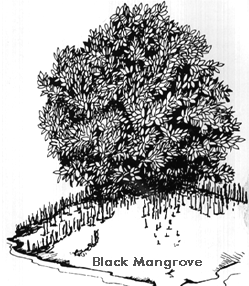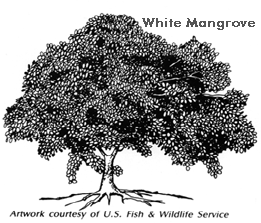Wetlands
 Wetlands are generally defined as a natural community where water is at or covering the surface of the ground for all or part of the year. Coastal Wetlands typically include mangroves, saltwater marshes, and seagrasses.
Wetlands are generally defined as a natural community where water is at or covering the surface of the ground for all or part of the year. Coastal Wetlands typically include mangroves, saltwater marshes, and seagrasses.
For most of Florida’s history, wetlands were viewed as worthless swamps to be filled for more productive uses, such as agriculture and home sites. Today, wetlands are recognized and protected for their value as habitat for birds and other wildlife, and for their role in protecting waterbodies from pollution.
Wetlands help to filter damaging nutrients and other pollutants from stormwater runoff. They stabilize shorelines against erosion from fluctuating tides, storm surges and flooding.
Saltwater Marshes are marked by a preponderance of various grass-like plants such as cordgrass (Spartina alterniflora and others) and rushes (Juncus romerianus).
Seagrass Beds in Southwest Florida are generally composed of broad-bladed turtle grass (Thalassia), and finer leafed manatee grass (Halodule wrightii) and shoal grass. Like all green plants, seagrasses are dependent upon sunlight for photosynthesis.
Once extensive throughout the bays, dredging, filling, prop scarring from boats and decreased water quality from urban runoff, have greatly reduced the abundance of seagrasses.
Healthy seagrass communities are among the most productive natural habitat. The seagrass blades provide food for grazing herbivores such as manatees and sea turtles; provide a nursery for the juvenile stages of commercially and recreationally important species of fish; and provide a substrate to support the growth of a myriad of microorganisms.
Mangroves
Mangroves thrive in salty environments because they are able to obtain fresh water from saltwater. Some secrete excess salt through their leaves, others block absorption of salt at their roots.
Mangroves trap and cycle various organic materials, chemical elements, and important nutrients.
Mangrove roots act not only as physical traps but provide attachment surfaces for various marine organisms. Many of these attached organisms filter water through their bodies and, in turn, trap and cycle nutrients.
Mangroves provide protected nursery areas for fishes, crustaceans, and shellfish. They also provide food for a multitude of marine species such as snook, snapper, tarpon, jack, sheepshead, red drum, oyster, and shrimp.
Many animals find shelter either in the roots or branches of mangroves. Mangrove branches are rookeries, or nesting areas, for beautiful coastal birds such as brown pelicans and roseate spoonbills.

Red Mangrove
Three species of mangroves are found in Florida, the red mangrove (Rhizophora mangle), is probably the most well-known. It typically grows along the water’s edge. The red mangrove is easily identified by its tangled, reddish roots called Aprop roots.

Black Mangrove
The black mangrove (Avicennia germinans), usually occupies slightly higher elevations upland from the red mangrove. The black mangrove can be identified by numerous finger-like projections, called pneumatophores, that protrude from the soil around the tree’s trunk.

White Mangrove
The white mangrove (Laguncularia racemosa) usually occupies the highest elevations farther upland than either the red or black mangroves. Unlike its red or black counterparts, the white mangrove has no visible root systems. The easiest way to identify the white mangrove is by the leaves. They are elliptical, light yellow green and have two distinguishing glands at the base of the leaf blade where the stem starts.
Mangrove forests protect uplands from storm winds, waves, and floods. The amount of protection afforded by mangroves depends upon the width of the forest. A very narrow fringe of mangroves offers limited protection, while a wide fringe can considerably reduce wave and flood damage to landward areas by enabling overflowing water to be absorbed into the expanse of forest. Mangroves can help prevent erosion by stabilizing shorelines with their specialized root systems. Mangroves also filter water and maintain water quality and clarity.

